Are you looking to bring a little sunshine indoors?
Maybe it’s time to start your flower and vegetable seedlings.
Perhaps your houseplants are drooping during the short days of winter, or sulking in a new home.
Or maybe you simply want to enjoy the taste of your own fresh herbs year round.
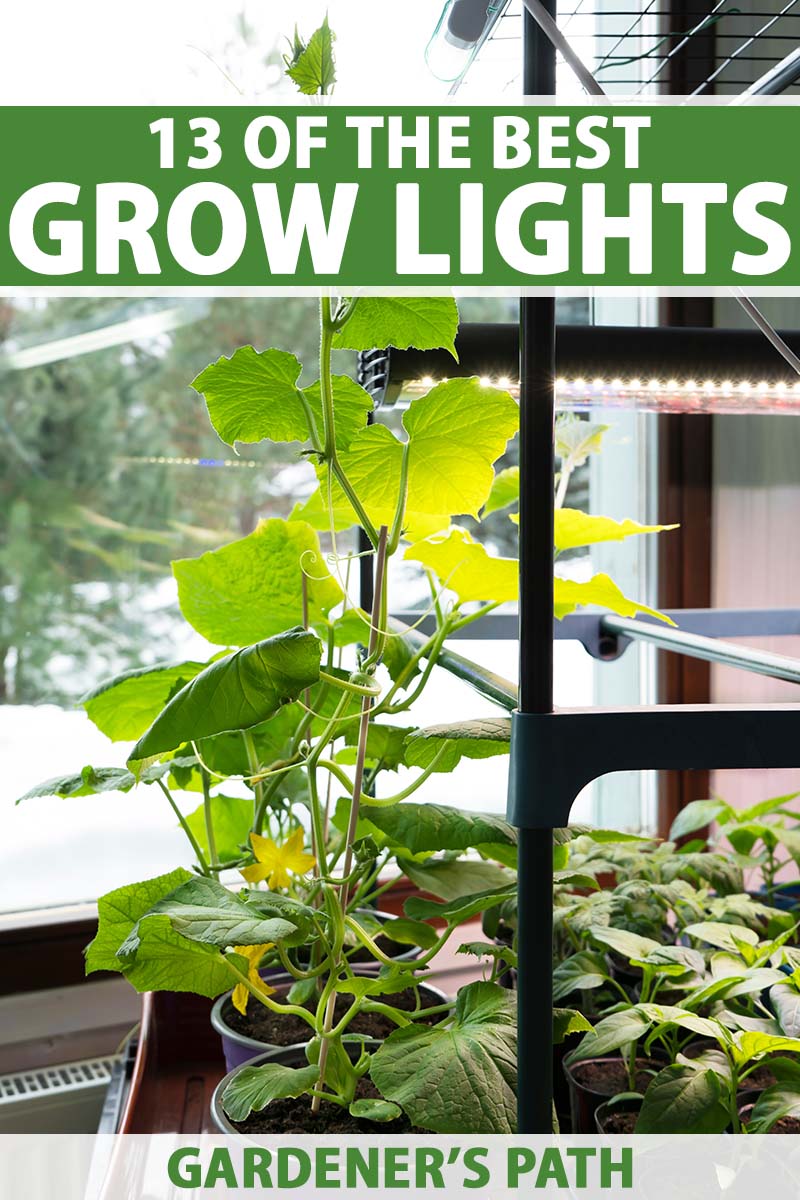
We link to vendors to help you find relevant products. If you buy from one of our links, we may earn a commission.
Whatever your need, grow lights can instantly provide hours of mock sunshine that your plants need for vigorous, healthy development.
They can provide any color spectrum required for every stage of growth and are easy to set up. The lamps run cool to the touch, are low wattage, energy efficient, and have long lives.
This also makes them economical. And by starting your own seedlings, you’ll quickly recover the cost with fewer trips to your local nursery!
But they do come in a huge array of shapes, sizes, and configurations.

To simplify matters, we looked for units from reliable brands that are well-designed, easy to set up and use, and provide effective coverage – and collected a few recommendations from our own writers, of course!
Here’s our take on 13 of the best grow lights for indoor plants and seedlings.
13 of the Best Grow Lights for Your Indoor Garden
To help you choose the right setup for your own indoor garden, we’ve also included a handy buyer’s guide explaining the different features and what to look for when you shop.
This includes the following:
Freestanding
Freestanding units typically have one or two tiers for plant trays and require a suitable location to accommodate their size. They are available with either LED or fluorescent bulbs, and some have casters so you can move them around easily.
Unlike the modular units, these come in fixed sizes.
1. Glow ‘n’ Grow Garden Cart
Burpee’s Glow ‘n’ Grow Garden Cart is a single-tier system constructed from powder coated aluminum, with four large casters for easy maneuverability.
The low-profile canopy has been designed to give complete plant coverage from the four 22-inch LED tubes.
Glow ‘n’ Grow Garden Cart from Burpee
The canopy fixture has a variable lamp-to-tray height of 20 inches, and is easily adjusted with the suspension chains on the overhead crossbar. This should be enough for starting seeds as well as growing small pots of herbs.
The cart has a generous single shelf that accommodates up to four standard-size plant trays without overcrowding.
Sturdy and easy to set up, the garden cart measures approximately 49 (L) by 23 (W) by 28.5 (H) inches.
Features
- Freestanding with casters
- Light deck adjustable to 20 inches above the tray
- Four LED tubes included
- 49 x 23 x 28.5 inches
- Accommodates four standard-size seed trays
Pros
- Casters for easy maneuverability
- 20-inch maximum lamp height accommodates seedlings and herbs
Cons
- Can’t expand if you want more growing area
- Seed trays are not included
A good choice for those who want easy portability for seasonal use and storage. However, if you think you might want to expand your indoor garden, you might consider one of the modular options described below instead.
See the Glow ‘n’ Grow Garden Cart now at Burpee.
2. Burpee 2-Tier Garden Cart
Burpee’s aluminum frame, two-tier garden cart doubles the available area for seedlings or plants by going vertical, but still maintains a compact footprint – with overall measurements of only 27 by 12 by 40 inches.
The two lamp fixtures each house two 24-inch T12 wide-spectrum fluorescent bulbs (750 lumens each) for full coverage at all development stages.
Plus, each fixture has a built-in electrical socket at one end – an ideal setup for use with heating mats.
Each tier comes with a 22-by-11-inch watertight plant tray made of BPA-free plastic. Canopy fixtures are easy to adjust on the uprights with a hand knob clamp, and provide a 16-inch lamp-to-tray clearance.
Features
- Freestanding, two tier
- Light decks adjustable to 16 inches above the tray
- Two T12 Fluorescent tubes per lamp fixture
- 27 x 12 x 40 inches
- 22 x 11-inch watertight plant tray
Pros
- Small footprint won’t take up much room
- Convenient electrical sockets for using heat mats
Cons
- No casters, so it can be difficult to move around
- T12 fluorescent tubes are older technology and have lower output than T5 bulbs
Compact and efficient, this is a smart, space-saving choice – and a wonderful option if you like to use heat mats for seed germination.
See the two-tier cart at Burpee now or head to Amazon to check prices and customer reviews.
3. Hydrofarm Jump Start Grow Stand
The Jump Start Grow Stand from Hydrofarm is a sturdy, powder-coated aluminum frame with reinforced top bar that gives full coverage for greens, seedlings, and small plants. And the entire frame snaps together easily with robust connectors – no tools required.

Hydrofarm Jump Start Grow Stand
The stand comes with a 24-inch, high-output, 6400K T5 fluorescent lamp (2,000 lumens) in a hooded, reflective fixture. The fixture height is easy to adjust with a simple toggle clamp and pulley system, and gives effective coverage to plants below.
It has an in-line on/off switch and comes in two sizes: 26 by 18 by 24 inches and 50 by 18 by 31 inches.
It doesn’t have casters. The bottom tray (not included) rests on the ground, instead of being elevated. With only one bulb, it may not have as much horizontal coverage as you require.
Features
- Freestanding frame with suspended light
- Light adjustable to approximately 20 inches
- One high-output T5 fluorescent tube with reflective hood
- Two sizes: 26 x 18 x 24 inches and 50 x 18 x 31 inches
Pros
- Small footprint
- Ideal for starting seeds or growing microgreens
Cons
- Single fluorescent tube doesn’t provide maximum horizontal coverage
- When positioned at max height, light isn’t strong enough to reach lower leaves on mature plants
- No tray
This model provides effective lighting for growing indoor plants and starting seedlings, in a well-designed stand that doesn’t take up too much room. It’s ideal for those who are just getting started with indoor gardening.
Check customer reviews and prices on Amazon now.
Stackable Modular Units
Stacking, or modular units are similar to the freestanding models, but give you the option of expanding your indoor garden space over time if you want to.
4. Low Bamboo Stacking Garden
Gardener’s Supply Company has handsome, stackable bamboo racks that are ideal for cultivating herbs, houseplants, or succulents.
The bamboo garden system includes two 6400K, full spectrum LED lamps (3,960 lumens) for complete coverage over the base, and a clear acrylic cover tops the reflective lamp fixtures.
The lamps are fitted 12 inches above the tray. These are not adjustable, so select your plants accordingly.
A galvanized steel tray sits neatly in the base, and the unit measures approximately 38 by 19 by 18.5 inches.
The furniture-quality bamboo frames are strong (able to hold up to 50 pounds) and attractive enough for placement in a permanent location in your home. And the materials are acquired by the manufacturer from a sustainable source.
A rolling base is available separately via Amazon for added portability, and you can stack two or more of these units on top of each other when your garden expands.
Features
- Freestanding stackable bamboo frame with 50-pound weight capacity
- Fixed lamp height 12 inches above the tray
- Two high output 6400K LED tubes
- 38 x 19 x 18.5 inches
- Galvanized steel tray
Pros
- Stylish design looks attractive in your home
- Stackability means you can expand your indoor garden with additional racks
- LED bulbs provide good horizontal coverage, and are recessed to prevent glare
Cons
- Lamp height is not adjustable
This model is ideal for growing herbs in your kitchen without compromising your decor.
Check prices now at Gardener’s Supply Company.
5. Stack-n-Grow Base Unit Garden Starter Kit
The modular Stack-n-Grow system is a sound choice for going vertical. Start with the base and add up to two more units for extensive seed propagation that maintains a small footprint.
Stack-n-Grow Base Unit Starter Kit
Made from recycled polypropylene, the base measures a compact 31 by 15.5 by 21 inches and can hold up to 110 pounds.
Two 36-inch, 6400K, full-spectrum T5 fluorescent bulbs (3,730 lumens) give optimum coverage, and the high-tech reflectors shine directly onto plants for vigorous growth with less glare.
The unit is easy to assemble without using tools, and you can take it apart to store when it’s not in use.
Features
- Freestanding modular system of robust, lightweight polypropylene
- Light adjustable to 20 inches above the bottom tray
- Two 36-inch T5 fluorescent bulbs with reflectors
- 31 x 15.5 x 21 inches
Pros
- Easy to assemble without tools, and take apart to store when not in use
- Can stack two more units on top as your garden expands
Cons
- When stacking two or more units, you may need to anchor it to a wall to prevent it falling over
- Drip trays are not supplied, so when you stack two or more units, water can leak onto the lights below
This is a well-rounded choice for the beginner, with the ability to expand when needed.
See the Stack-n-Grow Base Unit and check prices at Gardener’s Supply Company now.
6. SunLite 3-Tier Garden
Going vertical is always a smart solution when you want to expand your indoor garden, particularly for those living in smaller spaces or urban locales.
This portable, three-tier stand from SunLite allows you to triple your seedling and plant capacity. And it has large casters for easy maneuverability
The sturdy but lightweight aluminum frame is powder coated for durability, and each of the three tiers houses an adjustable light fixture..
Fixtures hold two four-foot, full spectrum, 6500K LED (2,400 lumens) tubes that are easy to adjust with a hoist chain and locking toggle.
The adjustable clearance from lamps to trays is 14.75 inches, and overall measurements are 51 by 14.75 by 68.5 inches.
Features
- Freestanding three-tier frame
- Lights adjustable to 14 inches above the trays
- Two full-spectrum 6500K LED tubes on each tier
- 51 x 14.75 x 68.5 inches
- Powder coated aluminum frame with plastic shelf trays
- Casters included
Pros
- Large growing capacity
- Casters make moving it around easy
- Adjustable lamp level for different stages of plant growth
Cons
- The position of the two LED tubes can mean horizontal light coverage is compromised for seedlings in outer parts of trays
- Bottom tier does not have a support bar for the tray, so it won’t hold heavier potted plants
Made in Vermont, this unit is a reliable choice for larger scale indoor plant production – without taking up all of your counter space.
Check prices and read customer reviews at Gardener’s Supply Company now.
Countertop Models
These models are more compact in nature, and suited for use on counters or tabletops.
7. SunBlaster Indoor Grow Garden
Sunblaster’s indoor garden kit is compact and self-watering – ideal for a countertop.
The heavy-duty base of recycled polypropylene acts as a four-quart reservoir, and a wicking capillary mat provides steady self-watering action for 14 to 21 days at a stretch.

An elevated stand holds the mat and four heavy-duty plant trays above the water, and seedlings are left undisturbed by the gentle bottom-watering.
The canopy houses two 24-inch, full spectrum, 6400K T5 fluorescent tubes (3,730 lumens) with nanotech reflectors, and built-in ballasts ensure maximum power output.
The canopy is easily adjusted on strong verticals with thumbscrew collars, and has a variable distance of 18 inches above the stand. This model measures 26 by 15.5 by 18 inches.
Features
- Countertop single-tier aluminum frame
- Lights adjustable up to 18 inches above the stand
- Two T5 fluorescent tubes with nanotech reflectors
- 26 x 15.5 x 18 inches
- Self-watering for 14 to 21 days
Pros
- Convenient automatic watering feature provides steady irrigation to your plants
- Light is adjustable to 18 inches above plants, giving your seedlings plenty of room to develop
Cons
- No room to expand if your garden gets bigger
This is the type that I have at home, and I love its compact efficiency.
It’s currently our second season together and I have zero problems to report – it’s perfect for plant-and-forget convenience. Just top up the water reservoir and raise the canopy every few weeks. I added a standard timer, available via Amazon, for virtually hands-free convenience.
Check current prices and read customer comments on Amazon.
8. SunBlaster Mini Greenhouse Nanodome
The SunBlaster Mini Nanodome delivers a complete, controlled environment in a breadbox-sized package – perfect for easy tabletop seed germination or growing microgreens.
SunBlaster Mini Greenhouse Nanodome
It includes a heavy-duty 10-by-20-inch planting tray and a sturdy, 10-inch, clear vented dome that creates a mini indoor greenhouse.
An 18-inch, full spectrum high output 6400K T5 fluorescent lamp (3,730 lumens) and strip reflector mounts to the dome top, and the six-foot power cord has an in-line on/off switch.
Features
- Plastic tray with clear plastic mini greenhouse cover
- One high output T5 fluorescent tube with nanotech reflector
- 10 x 20 x 10 inches
Pros
- Compact, lightweight starter system that takes up very little space
- Easy to move around or store when not in use
- Cover is easy to remove for watering and harvesting your greens
Cons
- Plastic dome feels a bit flimsy, so you can’t expand your garden vertically by stacking one on top of another
- Large drainage holes in the bottom of the tray mean you need to use a liner
A sturdy little system that offers convenience in a miniature package for growing herbs, microgreens, and seedlings, this one’s just right for small spaces.
Check prices and customer reviews now at True Leaf Market or at Amazon.
9. AeroGarden Harvest Elite Hydroponic Grow System
AeroGarden’s Harvest Elite is a compact hydroponic kit that includes everything you need to quickly cultivate and harvest six popular kitchen herbs – no soil required.
AeroGarden Harvest Elite Hydroponic Grow System
The canopy houses small blue, red, and white LED bulbs (1,500 lumens, 5500K total output) that supply optimal, full spectrum coverage to your plants in the sturdy base.
It has a timer so you can customize when you want the lights to switch on or off, and a handy “vacation” setting for when you are traveling. The digital control panel reminds you when it’s time to add plant food and water.
It includes seed pods of basil, Thai basil, dill, mint, curly parsley, and thyme and comes with a year’s supply of liquid plant food. Overall measurements are 10.75 by 7.5 by 10.5 inches and it has a 12-inch clearance from canopy to base.
Features
- Countertop unit in sleek stainless steel
- 5500K LED light canopy adjustable to 12 inches above the base
- Fully automatic set-and-forget timer, with reminder lights for feeding and watering
- 10.75 x 7.5 x 10.5 inches
- Ships with seeds and a year’s worth of liquid plant food
Pros
- Everything you need to get started with hydroponic herb gardening
- Fully adjustable on/off timer and handy “vacation mode” allow your plants to thrive while you are traveling
- Sleek, compact, modern unit looks stylish in your kitchen and won’t take up much space
Cons
- You can’t start seeds in soil with this unit
- Light bar doesn’t allow clearance for taller herbs
Easy and no-fuss, this is an excellent option for those who want to enjoy garden-fresh herbs all year.
Read customer reviews and check prices on Amazon. You can also buy this product directly from AeroGarden.
Lights Only
If you’re a do-it-yourselfer and don’t mind mounting a fixture, you can buy lights-only models, and install them yourself.
10. Hydrofarm Designer Grow System
Hydrofarm’s Designer low-profile lamp fixture has a durable, powder coated steel housing with a hammered finish. And it comes with multiple hanging options suited to a variety of locations.
Hydrofarm Designer Grow System
The fixture interior has a mirrored aluminum finish, and two energy efficient, high output, 6400K T5 fluorescent bulbs (4,000 lumens) give complete, full spectrum coverage.
The front-mounted on/off toggle switch and 10-foot grounded power cord add extra convenience.
It measures 24 by 7.5 by 2.5 inches and can be hung horizontally or vertically, or flush mounted. These units can also be daisy-chained together for customized configurations.
Features
- Powder-coated steel housing with reflective interior
- Two high output T5 fluorescent tubes
- 24 x 7.5 x 2.5 inches
Pros
- Easy to hang, and convenient for use in a variety of locations
- Long electrical cord
- Can connect two or more units to expand your indoor garden
- Bright, full spectrum light
Cons
- No built-in timer
If you need a good quality, versatile grow light for starting seeds or growing herbs indoors, this unit is an easy to use option, without a lot of extra bells and whistles.
Find prices and check customer reviews at Wayfair or on Amazon.
11. Feit Electric Adjustable Spectrum Lamp
Feit Electric’s adjustable color spectrum option solves the problem of determining which type of light to select.
Feit Electric Adjustable Spectrum Lamp Fixture
With three color settings available, you can quickly choose the one that’s best suited to your plants’ growth stage – blue for seedlings and vegetation, red for flowering, or full spectrum white for all stages of development.
The 6400K LED strips provide full brightness (1,300 lumens) with no appreciable heat output, and are integrated directly into the fixture so there are no bulbs to replace. A flip of the color-coded toggle switch selects the appropriate color.
The tough polycarbonate housing is smooth-edged and doesn’t rust or dent. It measures approximately 24 by 5 by 1.75 inches and can be flush mounted or hung using the included 6-inch wire harness. The power cord is 5 feet long.
Plus, you can link up to four units together as your indoor garden expands.
Features
- Robust, lightweight polycarbonate housing
- Two LED 6400K full spectrum strip lights
- 24 x 5 x 1.75 inches
Pros
- Lightweight, easy to hang with the included wire harness
- Adjustable color spectrum for different growth stages
- Cool operation doesn’t damage delicate seedlings
- Ability to link up to four units gives you flexible growing space
- Integrated unit with no bulbs to replace
Cons
- Bright lights can emit a lot of glare
If you are an experienced grower and want to customize your color spectrum, this is a top choice.
Check prices and read customer comments at Home Depot.
Home Lamps
Grow lights are excellent for seed germination and growing seedlings, and indoor plants love them too. Freestanding lamps can be the ideal solution for houseplants or succulents struggling with low light conditions.
These units come in floor, desktop, and clamping models.
12. Agrobrite Floor Plant Lamp
Agrobrite’s freestanding floor lamp is ideal for growing houseplants.

The wide, weighted base gives sturdy, balanced support, and a flexible gooseneck makes it easy to accommodate large or developing plants – but it doesn’t take up a lot of floor space.
It comes with an energy efficient, full spectrum, 5400K LED lamp (1,500 lumens) that mimic natural sunshine to keep plants healthy and vigorous. And the flicker-free glow is great for reading too.
The gooseneck adjusts from 48 to 61 inches, and it comes with a six-foot power cord with inline on/off toggle switch.
Features
- Freestanding floor lamp with weighted base
- Flexible gooseneck with replaceable 5400K LED bulb
- 48- to 61-inch adjustable height
Pros
- Does double duty as a reading light
- Takes up very little room in your home
- Six-foot power cord for flexible installation
Cons
- Not suitable for seedlings as it stands quite high off the ground
If you are looking for a freestanding grow light that does double duty as a reading light, then this is a good choice.
Find prices or check customer reviews at Amazon now.
13. Relassy Full Spectrum, Dual Head Gooseneck Plant Lamp
The dual head gooseneck lamp from Relassy is ideal for countertop or desktop use. It provides full spectrum, 5400K LED coverage suitable for all stages of plant growth.

Relassy Dual Head Gooseneck Lamp
The flexible goosenecks measure 18 inches and are made of rugged aeronautical aluminum.
Easily adjustable to any position, they hold the bulb fixtures in place without flopping from the weight. And a dual setting switch allows the lamps to be used separately or together.
Bulbs are easily replaceable, and the C-clamp securely attaches to counter, desk, or table edges up to three inches thick. It doesn’t stand up on its own though, so you will need something to clamp it to.
The manufacturer recommends wearing sunglasses to protect your eyes from the light emitted by these bulbs, and not to look directly at them. This limits the versatility of this unit, as you can’t use it as a desk light.
Features
- Two 18-inch flexible aluminum goosenecks with replaceable LED bulbs
- Robust C-clamp system to securely attach the unit
- Dual switch allows lights to be used separately or together
Pros
- Flexible goosenecks mean you can direct light to where you need it most
- The lights themselves are cool, and won’t damage seedlings
Cons
- Clamp can be difficult to use
- Power cord gets in the way of installation
- Light emitted from the lamps can be damaging to your eyes
- Although the bulbs are cool, the housing of the light fixtures can get hot after a few hours of use
This unit is a good choice if you have limited space and need a small but effective light for your houseplants.
Read customer reviews and check current prices at Amazon.
How to Choose the Best Grow Light for Your Indoor Garden
Grow lights provide a convenient, economical source of artificial sunshine, so your seedlings, indoor herb gardens, and houseplants can thrive throughout the year.
The lights and all-inclusive kits are easy to use, but there’s a huge variety of lamps to choose from.
From LED strips to fluorescent tubes, each has its own characteristics and strengths. And a basic understanding of their features can help you make a more effective decision when purchasing.
Let’s dig into the details a bit.
Why Grow Lights?
For plants to develop in a healthy manner, they need to capture and convert energy from the sun. This is the process of photosynthesis, and it provides plants with the fuel needed for vigorous development.
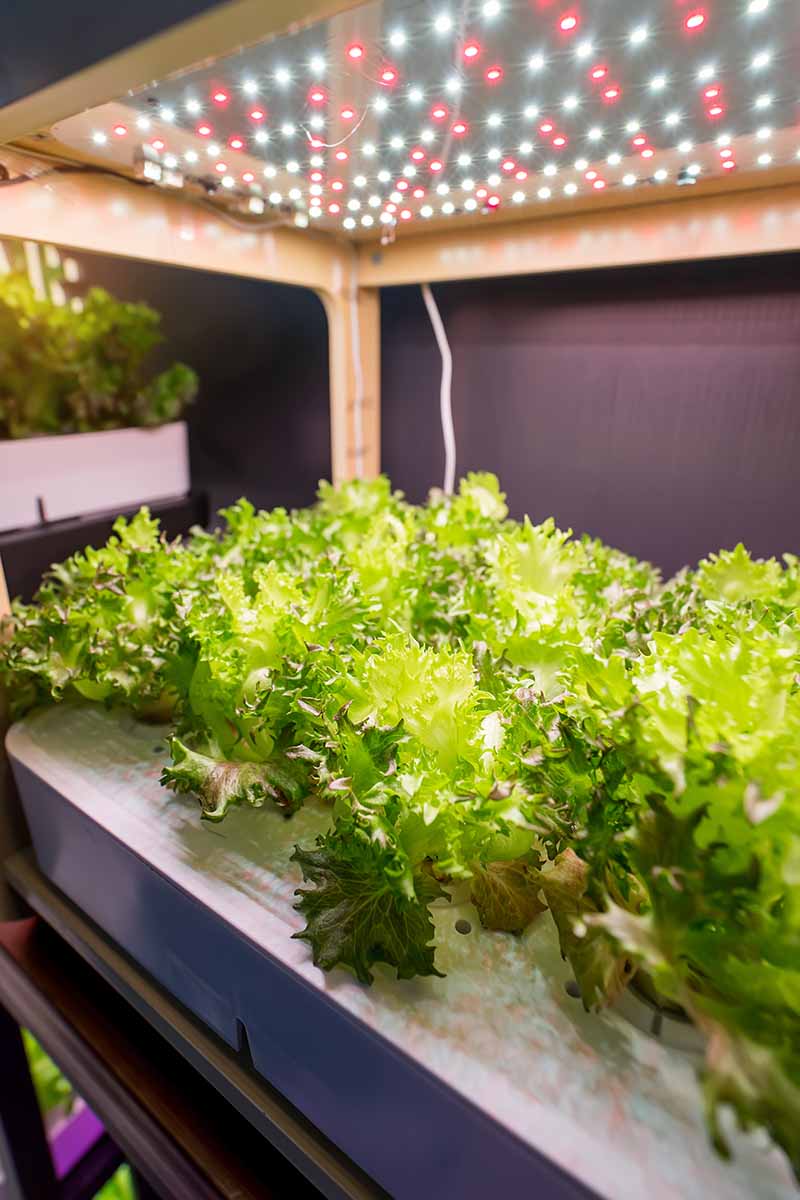
In the absence of adequate sunshine, plants can become leggy, stretch for the sun, and fail to thrive.
Grow lights provide an artificial source of luminous energy, providing the different frequencies in the color spectrum that plants need throughout all their phases of their development – from sprouting as seedlings to setting fruit.
The Electromagnetic Spectrum
The sun emits all the frequencies found within the electromagnetic spectrum, including those of visible light – violet, indigo, blue, green, yellow, orange, and red.
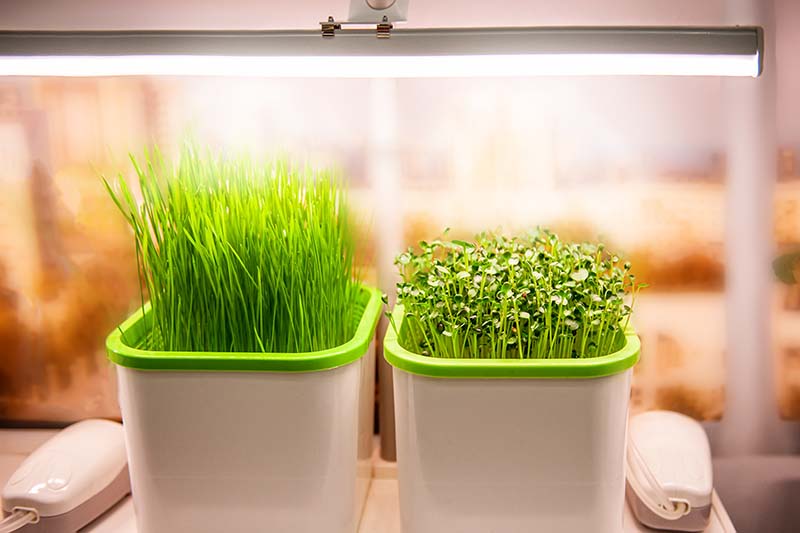
These are the frequencies plants need for normal development.
- Blue – Blue is the first color absorbed by plants and is essential at the beginning, or vegetative, stage.
- Purple – Purple also helps in the vegetative stage, although purple by itself does not provide effective energy for photosynthesis.
- Green – Green is primarily reflected, but small amounts are retained and contribute to energy conversion.
- Yellow – Yellow is the least effective for the purpose of photosynthesis.
- Red – Red is needed in the mature, flowering stage for blooms to form and is most effective when combined with blue. Red alone should not be used in the early, vegetative stages.
- White – White is the combination of all colors in the visible light spectrum and can be used effectively for all stages of a plant’s development.
So, for seedlings and leafy green vegetables, higher spectrum bulbs in the blue range are required.
But if you want plants to flower and set fruit, you’ll also need low spectrum red colors.
Or, you can make things easy. Use a full spectrum, white bulb to satisfy all stages of cultivation.
Types of Bulbs
A variety of specialized electric bulbs have been developed for indoor growing. The most common ones are:
- Compact fluorescent lamps (CFL)
- Fluorescent tubes
- High pressure sodium vapor (HPS)
- Light-emitting diodes (LED)
- Metal-halide (MH)
For the average home gardener looking to start a few trays of seeds, fluorescents and LEDs are the most popular and easily obtained.
Compact Fluorescent Lamps
Compact CFLs make a good choice for small spaces, and can be used in any regular incandescent bulb fixture.
But, due to their compact size, light distribution from a single CFL is limited and typically covers only a small space.
Fluorescent Tubes
Fluorescent tubes come in varying lengths and give much better coverage than CFLs, providing enough exposure for several standard seedling trays – depending on the length of the tubes.
They fit into a standard fluorescent fixture, but special full-spectrum tubes are required – regular household ones cannot be used effectively for growing plants.
High Pressure Sodium Vapor
High pressure sodium vapor lamps provide light in the yellow and red spectrum, and are typically used only in the flowering stage to encourage bloom set.
These are used by large scale growers to replace metal halide bulbs, once plants are finished with the vegetative stage. Most home growers do not use these bulbs.
Light Emitting Diode
LEDs come in small bulbs or strips, and offer the best long-term economy. Compared to fluorescents, LEDs provide a much higher luminosity, use half the electricity, produce little heat, and last up to five times longer.
But the typical household LED bulb isn’t designed for use on plants. Choose a full spectrum, combo, or isolated spectrum bulb suited to your needs.
Metal Halide
Metal halide bulbs emit a cool, blue-green color and are most efficient for larger growing operations where they can be operated at full power.
Initial prices are similar to those of LEDs, but MHs have a much shorter lifespan, and are not normally used in a home growing environment.
The Kelvin Scale
The Kelvin scale ranges from 1,000-10,000 and indicates a color’s temperature – the higher the Kelvin value, the closer a lamp’s color is to natural sunshine. Degrees of Kelvin are indicated by the capital letter K.
Ratings below 3500K typically have a warm value, showing an amber tint, while those with a higher rating get closer to a pure, or cool white color.
For leafy vegetative growth, a rating around 6500K is the ideal. But to generate flowers and fruit, plants require a period of exposure to warmer hues at approximately 3000K.
Lumens vs. Watts
It used to be that a bulb’s brightness was indicated by wattage. For example, a 100-watt bulb gave one and a half times the luminosity of a 40-watt bulb.
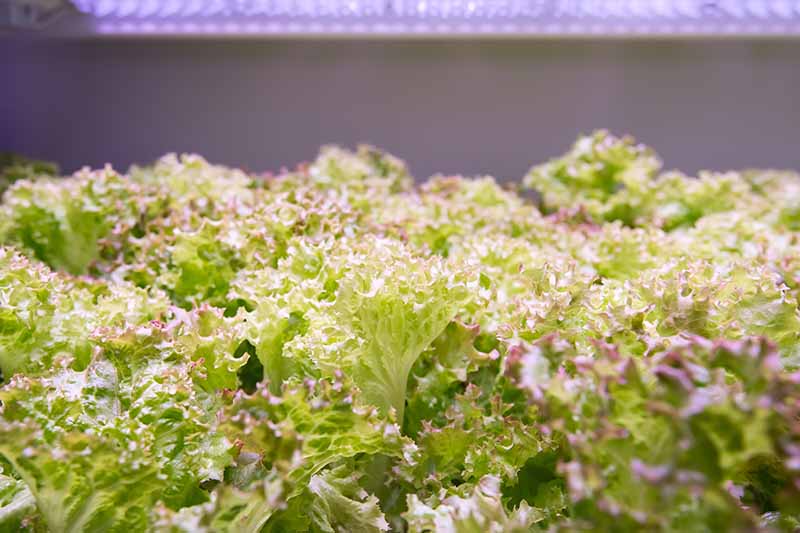
But due to the advent of energy efficient bulbs, wattage is no longer a good indicator of brightness. Wattage simply shows the amount of power drawn to produce a lamp’s brightness – which is now commonly indicated by lumens instead.
For example, an energy-efficient LED of 1,600 lumens has the equivalent brightness of one 100-watt bulb – but it only consumes up to 22 watts of power. And a comparably bright CFL bulb will use around 26 watts.
Basically, the higher the lumen value, the brighter the light will be. For seedlings, approximately 2,000 lumens per square foot is adequate. Flowering crops can require as much as 10,000 lumens per square foot.
Consider a Kit or Light Stand
If you’re buying light bulbs rather than a manufactured kit or stand, be prepared to do a little creative rigging.
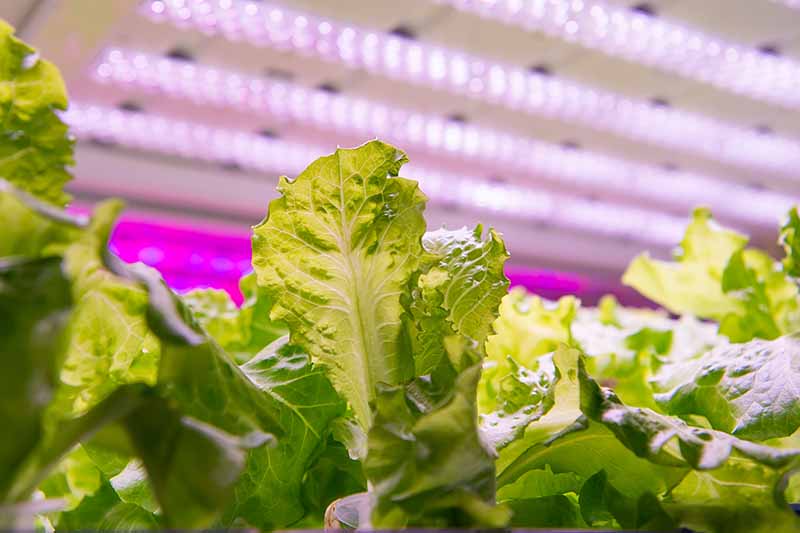
Lamps need to be adjustable in height to accommodate plants as they develop. In general, two to five inches between the lamps and the top of leafy growth is recommended.
Some bulbs will come with a built-in deflector to direct energy onto the plants, but others won’t – you may need to purchase a fixture to direct rays where they need to go.
A much easier solution is to invest in a kit or light stand.
Kits and stands typically have easily adjustable lamp fixtures to accommodate plants’ growth, and often include helpful accessories as well.
Accessories
A few well-chosen accessories such as these can help ensure the success of your indoor garden:
- Capillary mat – a capillary mat provides steady, gentle bottom watering so seedlings are never disturbed by vigorous water flow.
- Reservoir base – to use a capillary mat, a water reservoir is needed. Typically, water is added to the kit base and the mat sits on a shelf with the ends dipped into the water. The water is then absorbed into the mat and wicks moisture into the bottom of the trays.
- Timer – a timer is convenient for giving plants optimal light exposure without having to manually turn them on and off.
- Modular and stacking models – these provide the option of adding vertical tiers to increase capacity without requiring a larger footprint.
Tips for Growing Robust Seedlings
The following tips will help you to get the best results from your indoor garden:
1. If you’re new to starting seedlings indoors, begin with non-fussy plants that are easy to germinate and transplant.
Basil, coleus, cucumbers, kale, lettuce, marigolds, melons, nasturtiums, peppers, snapdragons, spinach, tomatoes, and zinnias are all good choices for the novice.
2. Use a high-quality, sterilized soil formulated for starting seeds. This is important, to prevent bacterial and fungal infections in tender sprouts.
Gardener’s Supply Company has horticultural-grade, finely ground coconut coir – excellent for germination and producing healthy seedlings.
3. Most seeds, even for cool weather crops like lettuce and spinach, require warm soil temperatures in order to germinate.
Household temperatures that reach 70 to 75°F for several hours each day should provide adequate soil temperatures.
To check your soil temperature, an ordinary kitchen thermometer works fine, or you can purchase one designed for horticulture, such as this one available via Amazon.
Keep soil temperatures within the range recommended on the seed packet, and if necessary, use a heat mat in cool cellars or unheated garages. One like this 9 x 19.5-inch mat from Hydrofarm available via Amazon fits standard seed trays.
4. It’s also important to keep the lamps very close to the seedlings, within two to five inches. Raise the fixture as plants increase in size.
5. Air circulation needs to be monitored as well. If your setup generates temperatures over 80°F, heat stress becomes a concern for tender shoots. Use a small fan to gently move the air if needed.
6. Water the soil with a gentle touch. To ensure delicate seeds aren’t disturbed by a strong water flow, water the soil thoroughly before planting. Then keep the soil evenly moist with a spray bottle, or allow trays to soak up water from the bottom.
7. Once seedlings have developed true leaves, gently separate any crowded clumps with a small fork, then replace in the tray until you are ready to transplant.
Let There Be Light!
Indoor gardening gets a lot easier with grow lights, and they enable you to cultivate plants at any time of year, in any climate.
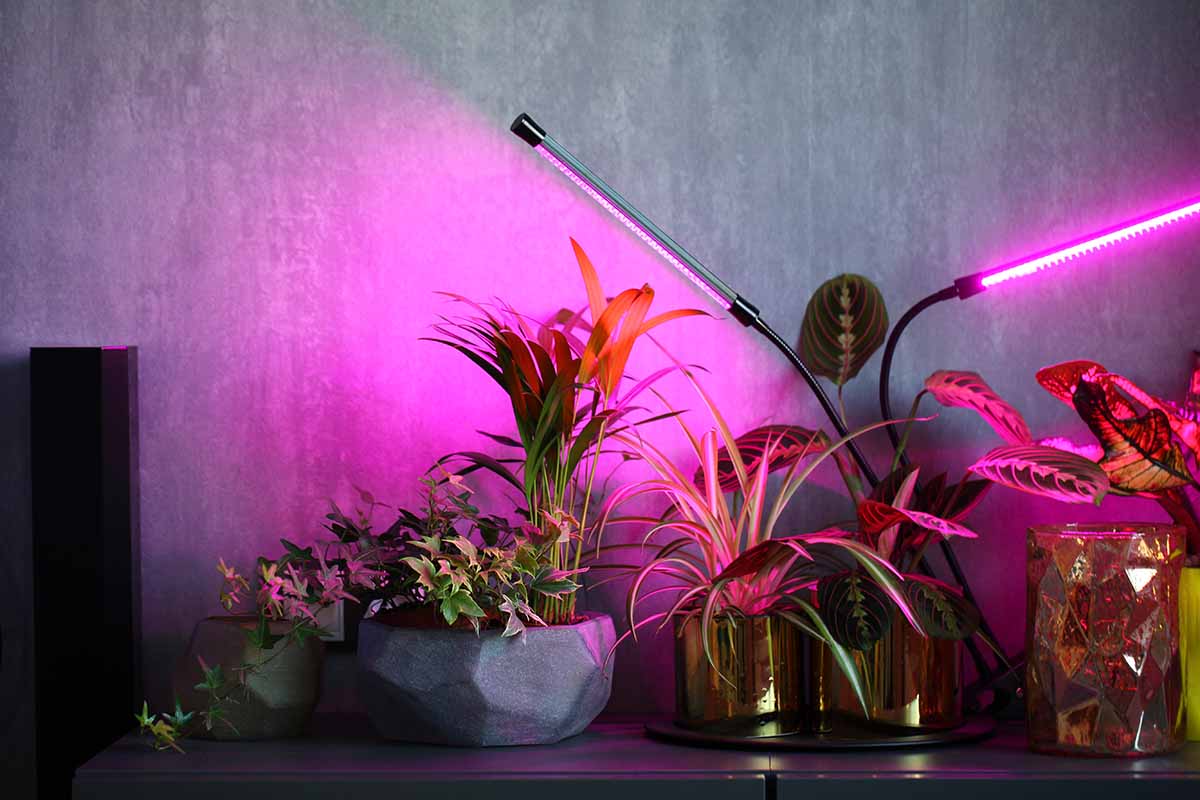
Start seedlings, nurture herbs and salad greens, or pamper your houseplants with lamps specifically designed to mimic natural sunlight – there’s a model available to suit just about any location or setting.
Easy to use and economical, you’ll love watching your plants flourish under their nurturing glow!
If you have any questions, or a model you’d like to recommend, drop us a note in the comments below. And if you’re ready to start gardening, be sure to read our tips on how to start annuals indoors from seeds.
And for more information about indoor gardening, check out these guides next:
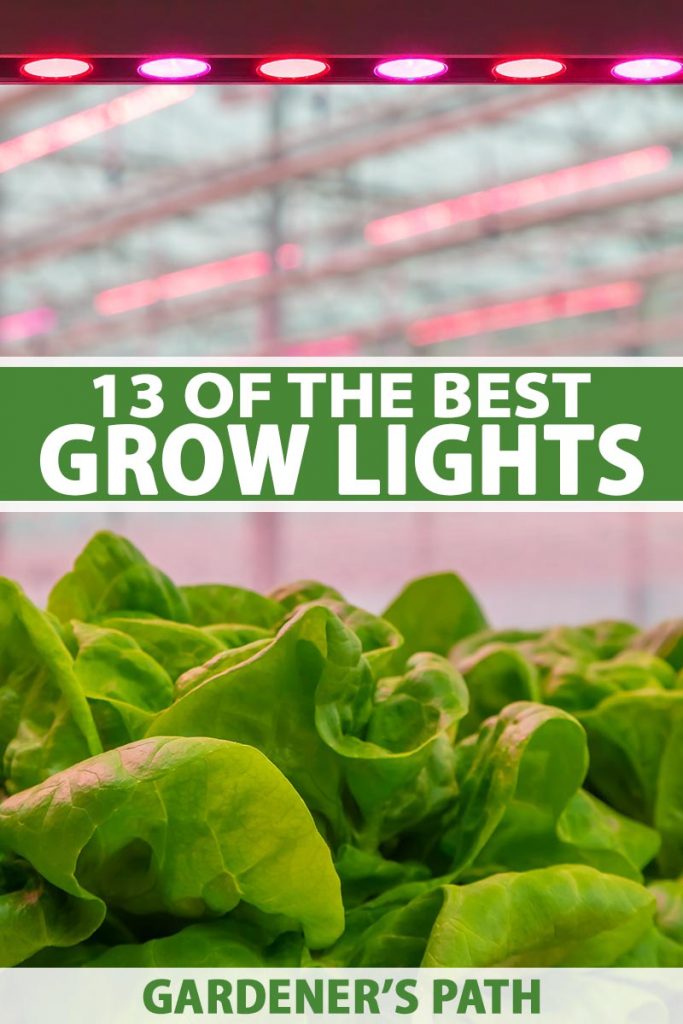
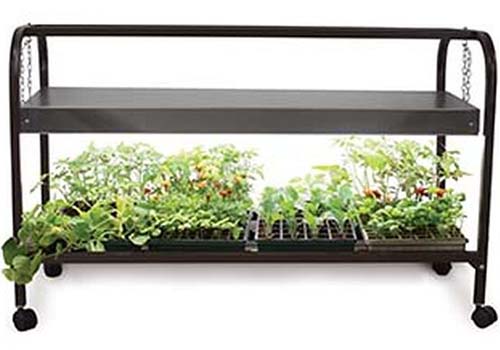
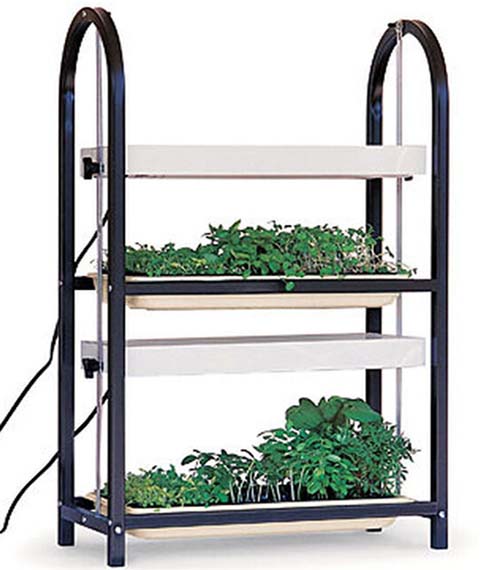
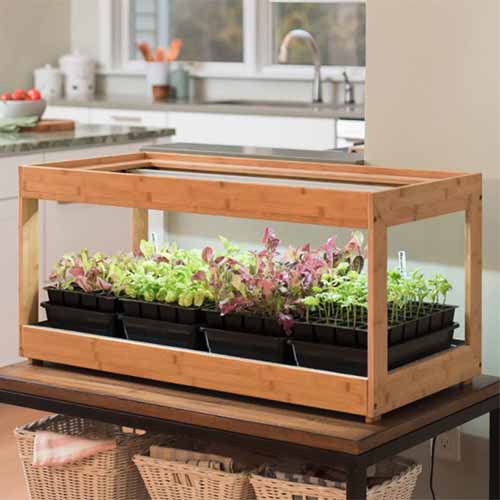
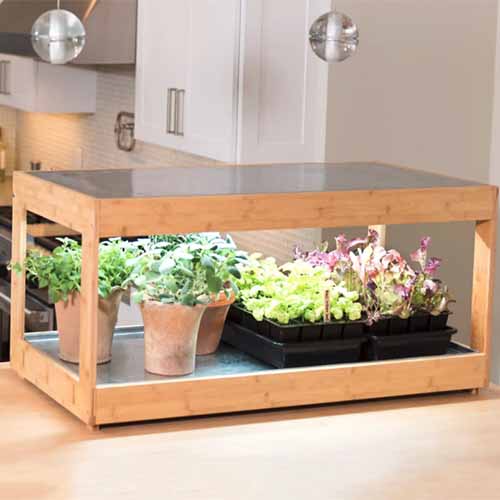



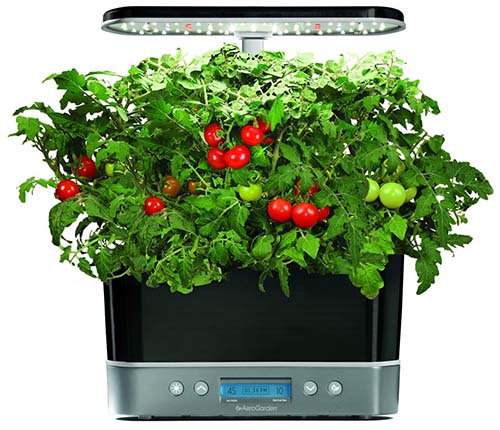
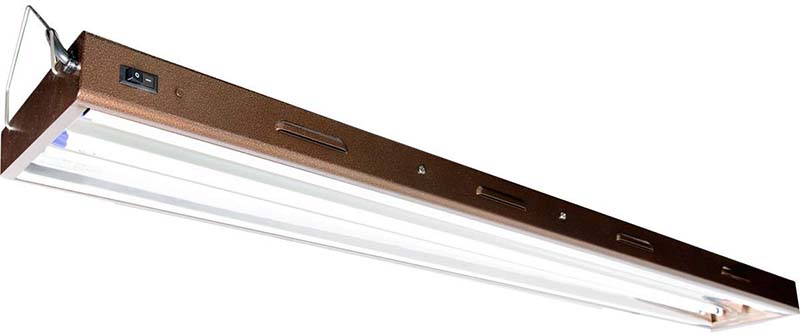

How long should I keep my grow lights on to help grow my succulent babies?
Hey Natalia, your new succulents should receive around 12 hours of light with 8 hours of dark per day.
If possible, time them to match the sun’s rhythm – coming on close to sunrise and going off at sunset.
Thanks for asking!
Great article. What type of lights do I need for the entire process from germination to grow for herbs and other vegetables? I would like to get lights that are good for the entire process.
Thanks
Hi John, the lights you want for complete start-to-finsh growth are full-spectrum bulbs.
These include the reds, blues, and white lights your plants need to thrive from seedlings through to fruiting.
Several of the models above use full spectrum bulbs and make a good choice for herbs and leafy greens – a good place to start your indoor garden.
Thanks for asking, and let us know how it works out for you!
Lorna, thanks for the prompt response.
I have found these lights to be incredible
https://www.amazon.com/dp/B07S7T583T
I am finding these discussions confusing. I simply want a grow light for my dwarf meyer lemon tree that will eventually result in fruit. Please advise.
Me too, Sue! I’m just trying to baby my Bearss Lime through Pennsylvania winter! Can anyone help us?
Hey Sue and Mary, depending on the size of your dwarf lemon and lime trees I suggest products like #12. Agrobrite Floor Plant Lamp or #13. Relassy Dual Head Gooseneck Plant Lamp.
Both provide the full spectrum light your plants require for growth, and they have adjustable necks that make it easy to place the light close to the canopy.
When do you start using the grow light on seedlings? As soon as you put the seeds in the soil, or after the seeds have germinated? Also, how far away is the light source from the plant?
Hey Russ, as a rule of thumb, small seeds that don’t require a covering of soil, or only a thin soil cover, should have the lights turned on as soon as they’re sown. Plants such as basil, lettuce, and summer savory need light. And have the canopy quite close to the soil surface, about two to four inches away, raising the canopy as the seedlings grow. Larger seeds, like beans, peas, corn, and squash, and those that require being covered in soil, generally germinate in the dark. For these, wait until they’ve broken the soil surface before turning the lights… Read more »
I always wanted to grow lettuce at home! Thank you for sharing this article.
Hey Lorna! This article helped me to understand a lot. I am new to indoor plants, and want to create a little oasis in my home I am moving too. I noticed this article has a lot about seedlings and fruiting/blooming. What would you suggest for a plant wall? I want to attach different plants to one of the walls. I figure I need something from my ceiling to shine down on them, would light would be best? And for fiddle fig trees etc that will be on the ground? Thank you so much!
Hi Rachelle – for your plant wall, I suggest something like #13, the Relassy Dual Head Gooseneck Plant Lamp.
It provides full spectrum light, the clamp makes it easy to attach to shelves or plant stands, and the two adjustable lights can be placed exactly where you want them to shine down on the growing plants.
For trees, I recommend a model like #12, the Agrobrite Floor Plant Lamp. It too has full spectrum light and the adjustable gooseneck makes it easy to accommodate growth.
Hope that helps, and thanks for asking!
Great info, thanks
Glad you think so Rich, thanks!
Glad to have found this site. My sister sent me a grow light. I just positioned it and turned it on for all spectrums. I wasn’t paying close attention to my indoor plants. Just watering and walking away. Then I took a good look. My short chiltepin pepper bushes, umbrella tree, lucky bamboo and bonsai were 2 feet or more taller and lush. My orchids all have 2-3 babies growing. I realized then that the orchids had been blooming more. I then hit the books and net to find out why. I found this article about lighting and suggestions highly… Read more »
Thanks for reading, Mary!
Hi
why have my radishes got large leggy stems?
Leggy vegetative growth can be an indicator of inadequate lighting. See our guide to growing radishes for tips.